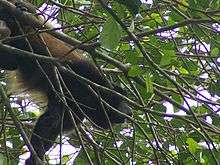Manuel Antonio National Park
| Manuel Antonio National Park | |
|---|---|
|
IUCN category II (national park) | |
|
The park is well known for sights of natural beauty similar to the above | |
 | |
| Location | Costa Rica |
| Nearest city | Quepos |
| Coordinates | 9°22′32″N 84°08′09″W / 9.37556°N 84.13583°WCoordinates: 9°22′32″N 84°08′09″W / 9.37556°N 84.13583°W |
| Area | 1 983 ha |
| Established | 1972 |
| Governing body | National System of Conservation Areas (SINAC) |

Manuel Antonio National Park, in Spanish the Parque Nacional Manuel Antonio, is a small National Park in the Central Pacific Conservation Area located on the Pacific coast of Costa Rica, just south of the city of Quepos, Puntarenas, and 132 km (82 mi) from the national capital of San José. Established in 1972 with a land area enumerating 1 983 ha (the smallest of any Costa Rican national park), it is the destination of as many as 150,000 visitors annually and well known for its beautiful beaches and hiking trails. In 2011, Manuel Antonio was listed by Forbes among the world's 12 most beautiful national parks.[1]
Features of the park
This park has one of the most impressive landscapes in the world and has several coves with many white sand beaches and lush foliage amidst great mountains and forests that reach the beaches. Additionally, it is located in the tropical forest.
For its excellent climate and scenic beauty is visited by large number of national and international tourism, for which it is currently developing an adequate infrastructure, with emphasis on harmony with nature, of quality but mimicked this to reduce the visual impact and under strict environmental protection, works designed by renowned architects bioclimatic Ibo Bonilla and Rafael Víquez, among which are the Visitor Centre, the Casa de Guardaparques, Lookouts and supporting infrastructure and Trails Master Plan that includes trails: Punta Catedral, Waterfall, Lookout, Beach Espadilla, Beach Manuel Antonio, Congos, Beaches Gemelas, Puerto Escondido, Manglar y trail Perezosos, with universal accessibility facilities, rest areas, scenic overlooks and scientific interpretation.
Beaches
Four beaches are contained within the limits of the park: Manuel Antonio, Espadilla Sur, Teloro, and Playita. With their large light sand berms, it is easy to see why they attract beach goers of all ages. The first is separated from the second by a "tombolo", or natural land bridge formed by sand accumulations. Visitors may enjoy a roughly hour-long hike from Espadilla to the top of Punta Catedral (100 m). Both Manuel Antonio and Espadilla Sur contain tidal pools and offer the possibility of snorkeling.
There is a lifeguard program, but precaution must be taken, as riptides occur.

Biodiversity
Although Manuel Antonio National Park is Costa Rica's smallest national park, the diversity of wildlife in its 6.83 km2 (3 sq mi) is unequaled with 109 species of mammals and 184 species of birds.[2] Both brown-throated three-toed sloth and Hoffmann's two-toed sloth are a major feature, as are three of Costa Rica's four monkey species — the mantled howler monkey, Central American squirrel monkey, and white-headed capuchin monkey. black spiny-tailed iguana, green iguana, common basilisk, white-nosed coati and many snake and bat species are also common in the park. Included in the 184 bird species[2] are toucans, woodpeckers, potoos, motmots, tanagers, turkey vulture, parakeets and hawks. Dolphins can be observed there, as well as the occasional migrating whale. Scuba diving, snorkeling, sea kayaking, mountain biking, and hiking provide opportunities to experience the tropical wildlife that enriches Manuel Antonio. Big monkeys rule these areas do not try to mess with them because the monkeys are vicious, and they will eat your food because they are fat.
Manuel Antonio is Costa Rica's second most visited park behind the Poás Volcano National Park which lies very close to San José, the country's largest urban area. The park's popularity has led to development of the surrounding areas, with environmental impacts to nearby forests and beaches.
The Pacific Ocean in front of Manuel Antonio Park is also world-renowned for its fishing. From November to April it is not uncommon for a typical angler to release multiple billfish in the over-100-pound range.
Tourism in the park
Manuel Antonio National Park is one of the most famous tourist destinations in Costa Rica, with easy access, ease and variety of services including all meals and accommodation and wide range of flora and fauna in such a small place, the park is among the most visited in the country.
Among the main attractions are the beaches surrounded by rainforest. Because of this, the park attracts surfers, swimmers, birders and ecotourists.
Galleries
- Sceneries
.jpg)

- Fauna in the park
- White-headed capuchin monkey in the park
- a small Ghost crab on a park beach
.jpg) Crab-eating raccoon on a park beach
Crab-eating raccoon on a park beach Mantled howler monkey howling
Mantled howler monkey howling Mantled howler monkey breaking stick
Mantled howler monkey breaking stick Central American Squirrel monkey
Central American Squirrel monkey Central American Squirrel monkey
Central American Squirrel monkey Three-toed sloth
Three-toed sloth Hoffmann's two-toed sloth
Hoffmann's two-toed sloth Male Ctenosaur/black iguana
Male Ctenosaur/black iguana Basilisk lizards fighting in the park
Basilisk lizards fighting in the park
See also
References
- ↑ Jane Levere (2011-08-29). "The World's Most Beautiful National Parks". Forbes. Retrieved 2011-10-04.
- 1 2 "Manuel Antonio National Park". Retrieved 2008-02-25.
External links
 Media related to Manuel Antonio National Park at Wikimedia Commons
Media related to Manuel Antonio National Park at Wikimedia Commons Manuel Antonio National Park travel guide from Wikivoyage
Manuel Antonio National Park travel guide from Wikivoyage- Manuel Antonio National Park at Costa Rica National Parks
